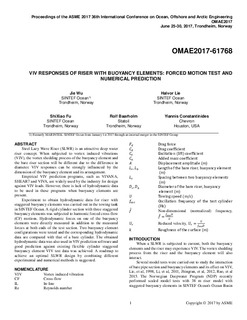| dc.contributor.author | Wu, Jie | |
| dc.contributor.author | Lie, Halvor | |
| dc.contributor.author | Fu, Shixiao | |
| dc.contributor.author | Baarholm, Rolf Jarle | |
| dc.contributor.author | Constantinides, Yiannis | |
| dc.date.accessioned | 2017-11-10T10:08:28Z | |
| dc.date.available | 2017-11-10T10:08:28Z | |
| dc.date.created | 2017-11-08T12:53:21Z | |
| dc.date.issued | 2017-06-25 | |
| dc.identifier.citation | ASME 2017 36th International Conference on Ocean, Offshore and Arctic Engineering - Volume 2: Prof. Carl Martin Larsen and Dr. Owen Oakley Honoring Symposia on CFD and VIV Trondheim, Norway, June 25–30, 2017 | nb_NO |
| dc.identifier.isbn | 978-0-7918-5764-9 | |
| dc.identifier.uri | http://hdl.handle.net/11250/2465502 | |
| dc.description.abstract | Steel Lazy Wave Riser (SLWR) is an attractive deep water riser concept. When subjected to vortex induced vibrations (VIV), the vortex shedding process of the buoyancy element and the bare riser section will be different due to the difference in diameter. VIV responses can be strongly influenced by the dimension of the buoyancy element and its arrangement. Empirical VIV prediction programs, such as VIVANA, SHEAR7 and VIVA, are widely used by the industry for design against VIV loads. However, there is lack of hydrodynamic data to be used in these programs when buoyancy elements are present. Experiment to obtain hydrodynamic data for riser with staggered buoyancy elements was carried out in the towing tank in SINTEF Ocean. A rigid cylinder section with three staggered buoyancy elements was subjected to harmonic forced cross-flow (CF) motions. Hydrodynamic forces on one of the buoyancy elements were directly measured in addition to the measured forces at both ends of the test section. Two buoyancy element configurations were tested and the corresponding hydrodynamic data are compared with that of a bare cylinder. The obtained hydrodynamic data was also used in VIV prediction software and good prediction against existing flexible cylinder staggered buoyancy element VIV test data was achieved. A roadmap to achieve an optimal SLWR design by combining different experimental and numerical methods is suggested. | nb_NO |
| dc.language.iso | eng | nb_NO |
| dc.relation.ispartof | ASME 2017 36th International Conference on Ocean, Offshore and Arctic Engineering - Volume 2: Prof. Carl Martin Larsen and Dr. Owen Oakley Honoring Symposia on CFD and VIV | |
| dc.relation.ispartofseries | ASME Proceedings | Prof. Carl Martin Larsen and Dr. Owen Oakley Honoring Symposia on CFD and VIV;OMAE2017-61768 | |
| dc.rights | Navngivelse-Ikkekommersiell-DelPåSammeVilkår 4.0 Internasjonal | * |
| dc.rights.uri | http://creativecommons.org/licenses/by-nc-sa/4.0/deed.no | * |
| dc.subject | Buoyancy | nb_NO |
| dc.subject | Risers (Casting) | nb_NO |
| dc.subject | Pipeline risers | nb_NO |
| dc.subject | Vortex-induced vibration | nb_NO |
| dc.title | OMAE2017-61768 VIV Responses of Riser With Buoyancy Elements: Forced Motion Test and Numerical Prediction | nb_NO |
| dc.type | Chapter | nb_NO |
| dc.description.version | acceptedVersion | nb_NO |
| dc.rights.holder | Copyright © 2017 by ASME | nb_NO |
| dc.identifier.doi | 10.1115/OMAE2017-61768 | |
| dc.identifier.cristin | 1512212 | |
| cristin.unitcode | 7566,8,0,0 | |
| cristin.unitname | Ocean Engineering | |
| cristin.ispublished | true | |
| cristin.fulltext | postprint | |
| cristin.qualitycode | 1 | |

